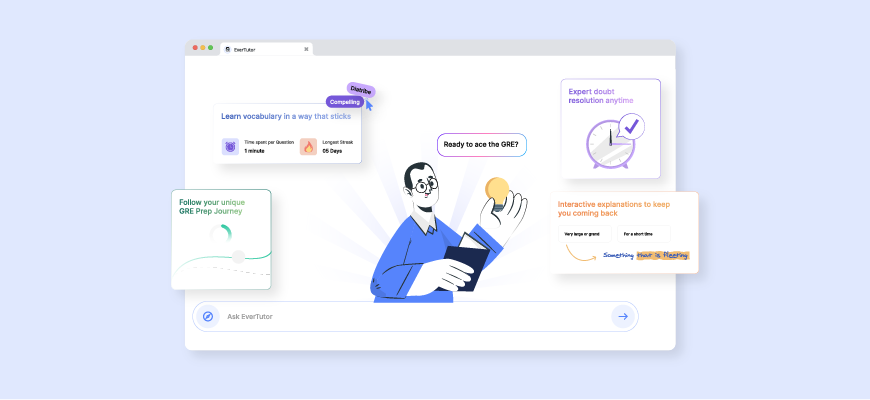New to the GRE and not sure where to start? You’re not alone.
The GRE is designed to test more than just knowledge- it evaluates your reasoning, problem-solving, and writing skills.
This guide will introduce you to the GRE’s question formats, provide realistic sample questions, and offer explanations that actually make sense. With added tips and support from EverTutor, you’ll learn how to study smarter and approach the test with confidence.


The Graduate Record Examination (GRE) assesses Verbal Reasoning, Quantitative Reasoning, and Analytical Writing skills. The current GRE lasts about two hours and tests reasoning and problem-solving abilities rather than rote memorization.
The exam begins with one 30-minute Analytical Writing task (“Analyze an Issue”), followed by two Verbal Reasoning sections and two Quantitative Reasoning sections. The GRE uses section-level adaptivity: your performance on the first Verbal or Quantitative section influences the difficulty of the next.
To truly understand the GRE’s question style and format, reviewing official sample questions provided by ETS(the test makers) is highly recommended. These authentic questions emphasize the test’s focus on reasoning skills.

Practicing with realistic GRE sample questions offers multiple advantages:

The GRE includes various question formats across Verbal and Quantitative sections:
For detailed examples and explanations of each format, you can explore the official ETS GRE Sample Questions PDF here

Text Completion:
“Though the documentary was informative, the narrator’s monotone delivery made the experience rather ____.”
A. engaging
B. soporific
C. thrilling
D. concise
E. enlightening
Answer: B. soporific
Explanation: The contrast word “though” signals that while the content was informative, the delivery was dull. “Soporific” means sleep-inducing, which fits best.
Tip: Look for contrast clues like “although,” “but,” or “despite.”
If stuck, take hints or ask EverTutor for a relevant story to better retain the meaning of “soporific.”
Sentence Equivalence:
“The student’s response was so ____ that it failed to clarify her position on the issue.”
A. ambiguous
B. vague
C. candid
D. articulate
E. forthright
F. unclear
Answer: A and F. ambiguous and unclear
Explanation: The response lacked clarity. Both “ambiguous” and “unclear” convey this meaning.
Tip: Select two synonyms that preserve the sentence’s meaning.
Use EverTutor’s mnemonic revision and recall words to strengthen your vocabulary retention.
Reading Comprehension:
“According to the passage, the primary reason the scientist rejects the common interpretation of the data is because:”
A. The data was collected from unreliable sources
B. The hypothesis was never peer-reviewed
C. The interpretation fails to consider all variables
D. The results contradicted earlier experiments
E. The sample size was too small to be meaningful
Answer: C. The interpretation fails to consider all variables
Explanation: This answer directly addresses the scientist’s reasoning.
Tip: Eliminate answers not directly supported by the passage, even if plausible.
Reset and try the question again on EverTutor after taking hints to deepen understanding.
Text Completion:
“Her novel’s prose is at once ____ and elaborate; it enthralls readers with its complexity while requiring careful attention.”
A. terse
B. lucid
C. ornate
D. succinct
E. intricate
F. convoluted
Answer: C and E. ornate and intricate
Explanation: The sentence suggests beauty and complexity, fitting “ornate” and “intricate.”
Tip: Match tone and meaning rather than individual word familiarity.
Look into word usage on EverTutor and ask for relevant stories to remember these words better.
Arithmetic:
“A recipe calls for 2.5 cups of flour. If you want to make one-third of the recipe, how much flour is needed?”
A. 0.75 cups
B. 0.8 cups
C. 0.83 cups
D. 1.25 cups
E. 1.5 cups
Answer: C. 0.83 cups (approximately 5/6 cup)
Explanation: (1/3) × 2.5 = 0.833…
Tip: Be comfortable converting fractions to decimals.
Use EverTutor’s personalized difficulty adjustment to practice questions at your skill level.
Numeric Entry:
“What is the median of the following numbers: 7, 9, 12, 15, 18?”
Answer: 12
Explanation: Median is the middle value when numbers are ordered. Here, the 3rd number is 12.
Tip: Don’t confuse median (middle value) with mean (average). Take hints and reset questions on EverTutor to fully grasp concepts.
Algebra:
“If y = 3x + 5 and x = –2, what is the value of y² – x?”
A. 42
B. 49
C. 55
D. 61
E. 67
Answer: 3
Explanation: y = 3(–2) + 5 = –6 + 5 = –1; y² = 1; y² – x = 1 – (–2) = 3.
Tip: Double-check intermediate steps in multi-part calculations.Revise through mnemonics on EverTutor for algebraic operations to speed recall.
Quantitative Comparison:
Compare Column A and Column B:
Answer: C. The two quantities are equal
Explanation: 4⁵ = (2²)⁵ = 2¹⁰.
Tip: Convert numbers to the same base before comparing.
Recall words and revive mathematical concepts on EverTutor repeatedly for mastery.
Word Problem:
“A train travels 180 miles at 60 mph. If it returns on the same route at 90 mph, what is the average speed for the round trip?”
A. 72 mph
B. 70 mph
C. 75 mph
D. 78 mph
E. 80 mph
Answer: A. 72 mph
Explanation: Average speed = 2 × 60 × 90 / (60 + 90) = 10800 / 150 = 72 mph.
Tip: Use harmonic mean for round-trip speed problems.
Personalized hints on EverTutor help clarify such formulas when you get stuck.
Issue Task Sample Prompt:
“Governments should prioritize scientific research that directly benefits society, rather than research that has no immediate practical use.”
Response Tip: Take a position and argue with clear examples (vaccines, space exploration), including a counterargument.
Argument Task Sample Prompt:
“A company noted that customer satisfaction increased after it began offering free shipping. Therefore, all future growth efforts should focus on free shipping initiatives.”
Response Tip: Identify logical flaws such as correlation vs. causation, and suggest data to evaluate the claim.
You can access the official GRE Sample Questions PDF here for comprehensive practice.

For comprehensive GRE preparation, combine official ETS sample questions with EverTutor’s adaptive learning platform. EverTutor personalizes your study plan based on your performance, provides mnemonic aids, optimizes hints (stories, word usage), and lets you reset questions for mastery.
With the $20 plan, unlock the UniSuggest feature to receive personalized university recommendations based on your GRE scores and profile- saving time and maximizing admission chances.
Get started with EverTutor today to revolutionize your GRE prep journey.
Begin by understanding the test structure and reviewing official GRE sample questions from ETS. Then, incorporate realistic practice with platforms like EverTutor, which provide personalized hints, mock tests, and vocabulary tools to enhance retention and confidence.
Sample questions help you become familiar with GRE question types, identify weak areas, improve time management, and reduce test anxiety. With platforms like EverTutor, you can take it a step further by receiving tailored explanations, smart timers, and adaptive practice.
The GRE includes three sections:
Focus on understanding the logic behind each answer. Use EverTutor’s features like:
✅ 1000+ Practice Questions with Step -by-Step AI Walkthroughs.
✅ Vocabulary Trainer for the most essential GRE words.
✅ 24/7 Real-Time Doubt Solving with an AI Tutor.
✅ 5 Full-Length GRE Mock Tests with instant AWA scoring.